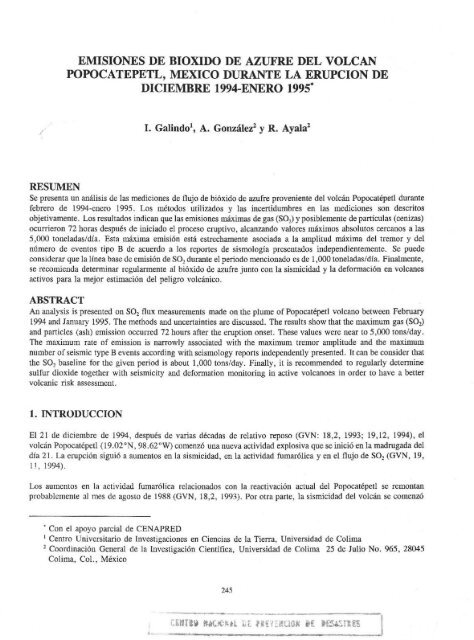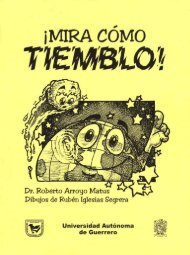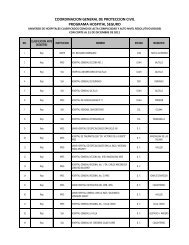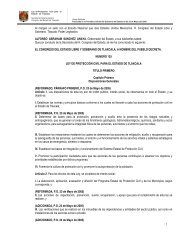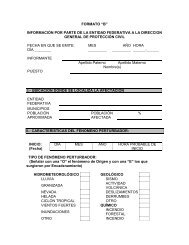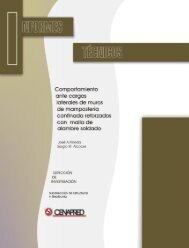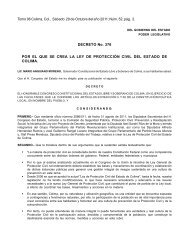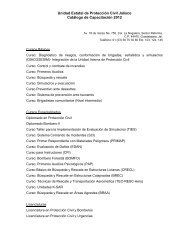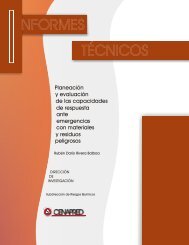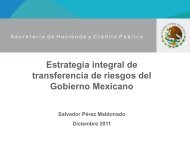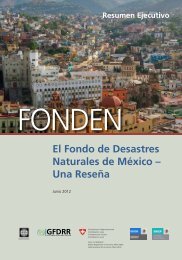- Page 2 and 3:
SISTEMA NACIONAL DE PROTECCION CIVI
- Page 4 and 5:
Presentación Introducción G. Suá
- Page 6 and 7:
CAPITULO VI. ASPECTOS GEOQUIMICOS Y
- Page 8 and 9:
INTRODUCCION Gerardo Suárez' Méxi
- Page 10 and 11:
CAPITULO I ANTECEDENTES HISTORICOS
- Page 12 and 13:
el Popocatépetl alrededor del año
- Page 14 and 15:
1512 - "Año de 7 Navajas y de 1512
- Page 16 and 17:
de fumarolas y cenizas probablement
- Page 18 and 19:
1 665 -En "El Mexicano", periódico
- Page 20 and 21:
Nuevamente, unas interesantes refer
- Page 22 and 23:
1 9 2 1 - El 24 de marzo el diario
- Page 24 and 25:
1 9 2 5 -Reporta Atl: "El 23 de . j
- Page 26 and 27:
1 9 9 4 -Febrero 11. Se establece e
- Page 28 and 29:
4. REFERENCIAS BIBLIOGRAFICAS [1] O
- Page 30 and 31:
[42] Robin C. & Boudal C. (1984). U
- Page 32 and 33:
MONITORED VOLCANICO: INSTRUMENTACIO
- Page 34 and 35:
Monitoreo sísmico. Monitoreo geod
- Page 36 and 37:
• localización precisa del sitio
- Page 38 and 39:
interpretación de los especialista
- Page 40 and 41:
... .:..., & .... ........... -. .
- Page 42 and 43:
ACCESO A LAS ESTACIONES DE MONITORE
- Page 44 and 45:
CENAPRED UNAM PCR • ESTACION DE R
- Page 46 and 47:
•• 4tM7r1 EBT^17_^I^^^^G .. . .
- Page 48 and 49:
FECHA DE ACTUALIZACION: marzo 30, 1
- Page 50 and 51:
^ ^^::c:^:Y.:#: ^.t ♦j .^c^yt i.
- Page 52 and 53:
, 7. DESCRIPCION GENERAL DE LA INST
- Page 54 and 55:
XI IX1 CASETA PARA ESTACION SISMICA
- Page 56 and 57:
Una vez acondicionadas y moduladas
- Page 58 and 59:
de la contracción y dilatación de
- Page 60 and 61:
RECEPTOR DE MICROONDAS MONITOR VISU
- Page 62 and 63:
Real-time Seismic Amplitude Measure
- Page 64 and 65:
La figura 19 muestra los datos de i
- Page 66 and 67:
Instituto de Ingeniería de la UNAM
- Page 68 and 69:
o ,_ *Et w ^ N 120.0 = o 90.0= á 3
- Page 70 and 71:
7:1 U N o 1.0 is 21 ^ 1.5 .0 ^ V o
- Page 72 and 73:
11. REGISTRO FOTOGRAFICO DE LA RED
- Page 74 and 75:
Figura 32, Caseta de protección de
- Page 76 and 77:
Figura 36. Caseta en construcción
- Page 78 and 79:
Figura 40. Instalación subterráne
- Page 80 and 81:
Figura 44. Torre con las antenas de
- Page 82 and 83:
14. REFERENCIAS Cenapred, Instituto
- Page 84 and 85:
CAPITULO III RIESGOS Y MAPEO ZONIFI
- Page 86 and 87:
Figura 1. Localización de los prin
- Page 88 and 89:
diversas erupciones independienteme
- Page 90 and 91:
Numerosos lanares se encuentran aso
- Page 92 and 93:
2.A Caída de Material Piroclástic
- Page 94 and 95:
5. CONCLUSIONES Y RECOMENDACIONES C
- Page 96 and 97:
INTEGRACION DE INFORMACION CARTOGRA
- Page 98 and 99:
Fig. 1. Detalle de Mapa de Toponimi
- Page 100 and 101:
Fig. 4. Modelo de elevación del te
- Page 102 and 103:
POBLACION EXPUESTA A DESASTRE EN LA
- Page 104 and 105:
Figura IA. Pluma de Ceniza 22 de Di
- Page 106 and 107:
Figura 3A. Pluma de ceniza 27 Dic.
- Page 108 and 109:
La población afectada sería de 21
- Page 110 and 111:
explosiva con abundante lluvia de c
- Page 112 and 113:
POSIBLE FLUJO DE LODO EN EL COSTADO
- Page 114 and 115:
ALTURA (KM) 5 4 3 2 1 PERFIL BARRAN
- Page 116 and 117:
Se tomaron muestras de ceniza tanto
- Page 118 and 119:
donde: qs O.05C'13 q1513 ^51 3 (Dr-
- Page 120 and 121:
El gasto líquido que entrará en c
- Page 122 and 123:
* Se estudió únicamente la barran
- Page 124 and 125:
9. APÉNDICE FOTOGRÁFICO Fotograf
- Page 126 and 127:
Fotografía 5. Vista aérea de las
- Page 128 and 129:
Fotografía 9. Personal del CENAPRE
- Page 130 and 131:
CAPITULO IV ASPECTOS GEOFISICOS SIS
- Page 132 and 133:
1. INTRODUCCION Las erupciones volc
- Page 134 and 135:
Tipo "A": Estos eventos son similar
- Page 136 and 137:
4. SISMICIDAD A partir de la crisis
- Page 138 and 139:
Localizaciones Hipocentrales -98.7
- Page 140 and 141:
Tokarev, P. I. 1978. Prediction and
- Page 142 and 143:
RESUMEN Entre el 1ro. de diciembre
- Page 144 and 145:
Tabla I. Operación Temporal de cin
- Page 146 and 147:
El tercer evento (Figura 5c) se sel
- Page 148 and 149:
7. TREMORES VOLCANICOS Uno de los c
- Page 150 and 151:
Para calcular la longitud de onda s
- Page 152 and 153:
1 I. REFERENCIAS Atl, Dr., 1939. Vo
- Page 154 and 155:
19.15 19.10 19.05 19.00 18.95 18.90
- Page 156 and 157:
Componente: Z i . t -I _t --•" s
- Page 158 and 159:
10 8 6 4 2 0 0 10 20 30 40 10 20 30
- Page 160 and 161:
10 8 6 4 10 8 6 4 o 2 0 o 10 20 30
- Page 162 and 163:
15000 10000 5000 0 -5000 o ib 10 2'
- Page 164 and 165:
-4000 , , , mi , i 0 2 4 6 8 4000 2
- Page 166 and 167:
10` 7 10' s-, 4 ^--^ 103 ^ 10' 10'
- Page 168 and 169:
1 5000 10000 5000 0 -5000 -10000 -1
- Page 170 and 171:
numerosos ejemplos de aplicaciones
- Page 172 and 173:
Si denotamos como a la distancia en
- Page 174 and 175:
-1 3 Figura 3 0 5000 9000 Profundid
- Page 176 and 177:
Las inclinaciones, dadas por la rel
- Page 178 and 179:
árbol de tres prismas roca firme y
- Page 180 and 181:
a) DET4tE VERT/CE TLAMACAS S D! LA
- Page 182 and 183:
junto con las inclinaciones y el vo
- Page 184 and 185:
descritos en la Figura 12. Entre la
- Page 186 and 187:
0.950 0.945 0.940 0.935 0.930 - 0.9
- Page 188 and 189:
0.840 0.835 0.830 0.825 0,820 0.815
- Page 190 and 191:
0.850 0.845 0.840 0.835 0.830 0.825
- Page 192 and 193:
11. CONCLUSIONES El análisis de lo
- Page 194 and 195: WAITZ, P. (1920) La nueva actividad
- Page 196 and 197: DERRUMBES GIGANTES, DEPOSIT,OS DE A
- Page 198 and 199: del volcán como un canal y devasta
- Page 200 and 201: 4. LOS DEPOSITOS DE AVALANCHA DE ES
- Page 202 and 203: h) O Fig. 3. Imagen de perspectiva
- Page 204 and 205: Fig, S. Cráter en forma de herradu
- Page 206 and 207: Los otros tres depósitos de avalan
- Page 208 and 209: Fig. 10. Topografía de montículos
- Page 210 and 211: Fig. 13. Cercamiento del afloramien
- Page 212 and 213: 300 cm 250 en Im LOCALIDAD 2-5 LOCA
- Page 214 and 215: Fig. 18. Afloramiento que muestra l
- Page 216 and 217: Fig. 20. Afloramiento en una mina d
- Page 218 and 219: 10. CONCLUSIONES Y TRABAJOS FUTUROS
- Page 220 and 221: Luhr, J. F. y Prestegaard, K. L., 1
- Page 222 and 223: MONITORED DE LOS GLACIARES DEL POPO
- Page 224 and 225: glaciares presentes en las cumbres
- Page 226 and 227: 3. LOS GLACIARES DEL POPOCATEPETL L
- Page 228 and 229: volcán. La porción noroeste se ha
- Page 230 and 231: lluvias que aportan suficiente agua
- Page 232 and 233: Para la determinación de espesores
- Page 234 and 235: su transportación. Descenso a la C
- Page 236 and 237: 35• 92 94 30.• 96 98 96 • 38'
- Page 238 and 239: Figura 3. Fotografía tomada el 28
- Page 240 and 241: MFX k4.-.Q Figura 5. Vista desde el
- Page 242 and 243: 8. REFERENCIAS Delgado, H., 1988, R
- Page 246 and 247: intensidad y dirección del viento
- Page 248 and 249: Los puntos 3 y 4 formalmente define
- Page 250 and 251: et al., 1985). Asimismo, la estrech
- Page 252 and 253: Figura 1. Volcán Popocatépetl vis
- Page 254 and 255: 9 3 2 1 2 3 4 5 6 7 8 9 10 11 12 13
- Page 256 and 257: ESTUDIO DE AEROSOLES Y CENIZAS DISP
- Page 258 and 259: De composición química, se utiliz
- Page 260 and 261: Se notó que durante las mediciones
- Page 262 and 263: Figura 3. Fotografía del volcán P
- Page 264 and 265: Tamaños d, pm Figura 4. Microscopi
- Page 266 and 267: * 1 2 3 4 5 6 7 Si 1027.000 624.000
- Page 268 and 269: Elemento Variaciones Error Mn 0.5-0
- Page 270 and 271: Se observa una pequeña variabilida
- Page 272 and 273: Suponiendo que el espesor de la nub
- Page 274 and 275: d,im 26.12 27.12 29.12 06.01 14.01
- Page 276 and 277: d,gm 26.12 27.12 29.12 06.01 14.01
- Page 278 and 279: Ivlev, L.S., Basov, L.L., Sirota, V
- Page 280 and 281: TABLA 2a. Intervalos dN(ri ri 1), c
- Page 282 and 283: TABLA U. Intervalos dN(ri-ri-1), cm
- Page 284 and 285: LA EMISION DE CENIZAS Y VARIACIONES
- Page 286 and 287: 4. ANALISIS DE LAS CENIZAS Las mues
- Page 288 and 289: 8. CARACTERISTICAS DE LOS LIXIVIADO
- Page 290 and 291: 13. REFERENCIAS Giggenbach. W.F., 1
- Page 292 and 293: 3 5 4 2 F3 }: !: 2 4 5 1.0 Ei'. Fig
- Page 294 and 295:
PATRONES DE VIENTO EN LA REGION DEL
- Page 296 and 297:
de ascender debido a la inercia y f
- Page 298 and 299:
en mb, en este trabajo por razones
- Page 300 and 301:
transicional, con una componente me
- Page 302 and 303:
8. REFERENCIAS Allard, P., D. Dajle
- Page 304 and 305:
Toluca I I a Querétaro a Pachuca I
- Page 306 and 307:
29% 24% PATRON DE VIENTOS MENSUAL L
- Page 308 and 309:
ENERO FEBRERO MARZO 5 IS 29 25 3 6
- Page 310 and 311:
E E o b o o ABRIL MAYO JUNIO Figura
- Page 312 and 313:
JULIO AGOSTO SEPTIEMBRE Figura 5.C.
- Page 314 and 315:
OCTUBRE NOVIEMBRE DICIEMBRE Figura
- Page 316 and 317:
26.3 20.6 16.5 10.9 5.8 ENERO FEBRE
- Page 318 and 319:
10.9 5.8 JULIO AGOSTO SEPTIEMBRE Fi
- Page 320 and 321:
CORTE TRANSVERSAL DE VIENTOS MEXICO
- Page 322 and 323:
CAPITULO VII ASPECTOS DE COMUNICACI
- Page 324 and 325:
2. MARCO TEORICO El peligro volcán
- Page 326 and 327:
NIVELES DE FENÓMENOS ASOCIADOS TIE
- Page 328 and 329:
El código propuesto aquí no puede
- Page 330 and 331:
INTERACCION DEL GRUPO CIENTIFICO CO
- Page 332 and 333:
RECONOCIMIENTOS Los estudios realiz
- Page 334:
- DR. ROBERT I. TILLING United Stat


